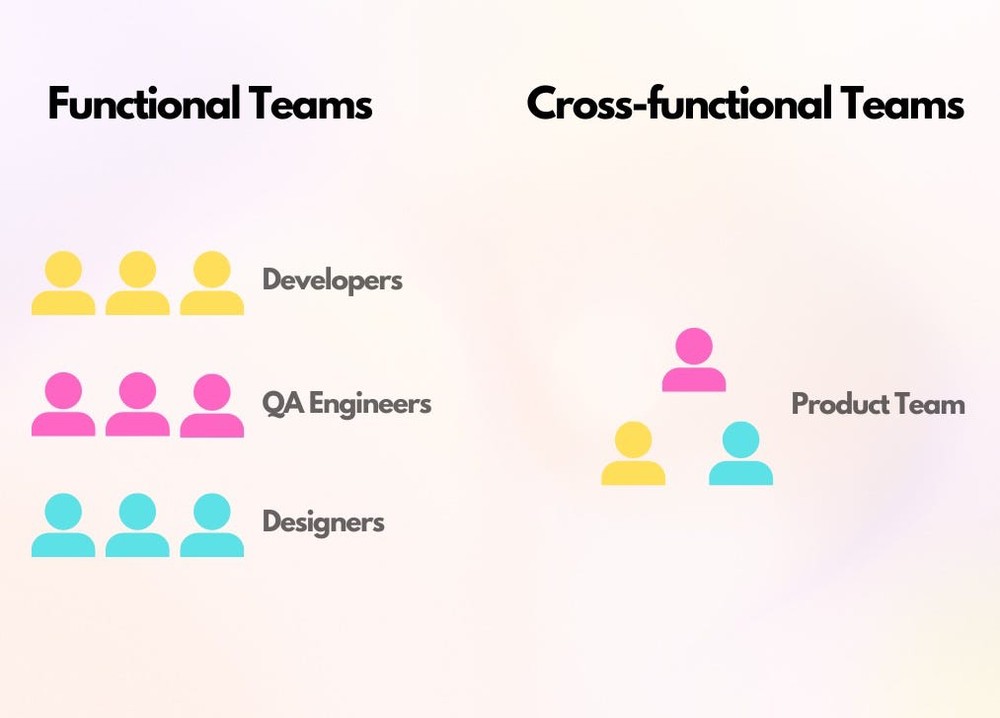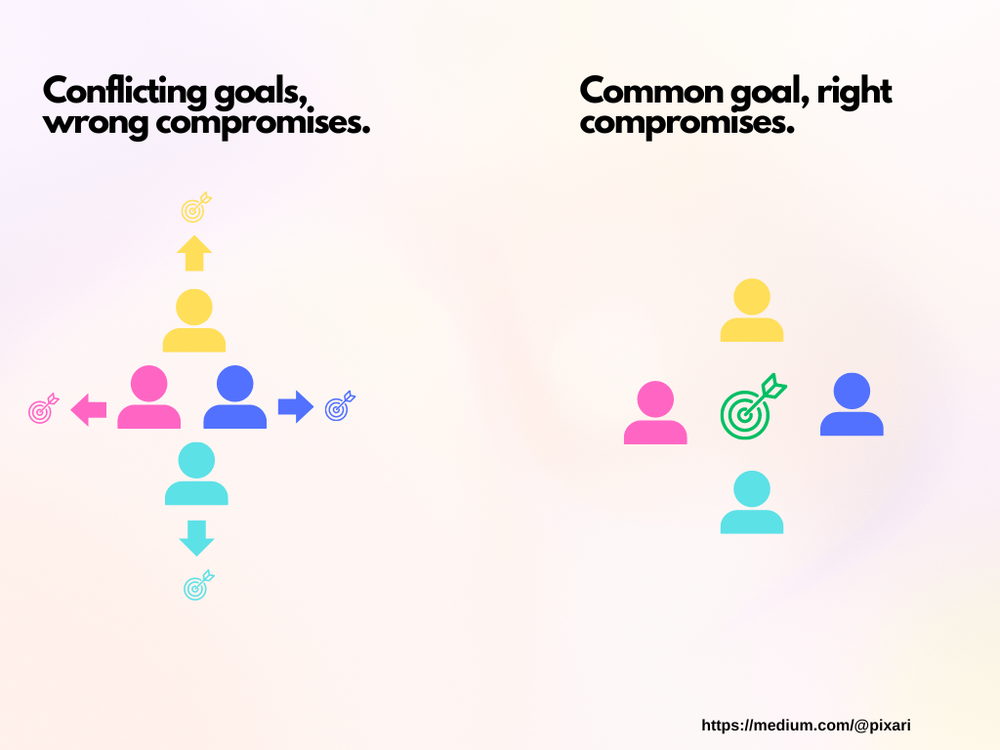Navigating the Challenges of Cross-functional Teams: the Role of Governance and Common Goals
Table of Contents
As a result, the teams struggled to meet deadlines, achieve both team and company objectives, fulfill management expectations, and deliver value. Internally, team members had difficulty fitting in, collaborating effectively, staying engaged, and reaching their full potential.
What I often found particularly odd was that most people seemed unaware of the underlying problems, even though they shared the same frustration.
I have noticed this pattern repeat itself multiple times. Despite the core causes being known, the journey to finding and implementing solutions has always been unnecessarily difficult and complex.
Simply put, the main problems are lack of governance and unclear common goals.
Cross-functional Team Setup
The cross-functional setup was established to move away from the conventional hierarchical organization that divides people by departments, bringing together a diverse group of individuals with varying skills and expertise to achieve a shared objective.

Individuals within the same group communicate quickly and efficiently, enabling them to anticipate problems faster and be more reactive to changes, unlike when different departments interact with each other.
Moreover, in such a group, the company goals are more effectively understood and represented due to the diverse range of perspectives, as opposed to within a single department.
Departments often prioritize their own goals, leading to silos. In contrast, cross-functional teams take a more holistic approach, enabling them to deliver business value effectively.
However, it’s not as simple as it sounds. Bringing together individuals with diverse skill sets doesn’t always work and can actually be quite unsuccessful if the groundwork isn’t laid properly.
There’s a considerable potential for friction and misunderstanding that we need to address. It’s essential to ensure everyone speaks the same specific language and is ready to agree on common processes and practices. If these aspects aren’t carefully considered and managed, it can lead to significant issues within the team.
Provide Governance
To ensure that the team stays on track and works towards the company’s overarching goals and vision, it’s crucial to have a dedicated and accountable individual overseeing their work, what we can call a cross-functional team manager. A strong understanding of the product, a clear grasp of the business and user needs, and solid technical skills are essential for this role.
I’m not suggesting an additional layer of hierarchy. On the contrary, the cross-functional team manager acts as a servant leader, offering the guidance necessary to keep the team aligned on common objectives.
The cross-functional team manager supports the team in developing effective processes and practices, identifies and resolves conflicts, and acts as a “proxy” between different professionals when needed. Additionally, they shield the team from external distractions, represent the team in higher-level meetings and are actively involved in project management to ensure proper planning and anticipate risks and impediments.
Effective governance provides clarity, a key factor for team success. And cross-functional teams have a large variety of topics that need to be clarified within the team:
- Do all team members understand their own roles as well as those of others?
- Is the team aware of the project’s success factors?
- Does the roadmap provide clarity, feasibility, and alignment with company goals?
- Is the team functioning autonomously, or are dependencies causing obstacles?
- Are conflict resolution procedures clearly defined for the team?
The cross-functional team manager doesn’t have to answer personally every question, it’s not their responsibility. In fact, in the team there are already enough competencies to address all the topics. They need to work as a facilitator, offering overarching guidance to empower the team.
Common Goals
Naturally, individuals with diverse skill sets and backgrounds tend to interpret their project differently. In cross-functional teams, this often leads to members focusing on varying priorities and, ultimately, pursuing different goals.
Riley (PM): “Thanks for coming. Let’s discuss the new feature. I’ve detailed the user stories.”
Morgan (Designer): “I’ve designed an impressive, dynamic interface for it.”
Cameron (Developer): “It looks great, but it’s complex and costly. We need to balance user experience and feasibility.”
Riley (PM): “These user stories are detailed to meet sales requirements. We need to follow them closely.”
Morgan (Designer): “I can’t cut corners on the design. If we don’t deliver a top-notch design, it won’t matter when we launch. Users won’t engage.” Morgan (Designer): “I can’t cut corners on the design. If we don’t deliver a top-notch design, it won’t matter when we launch. Users won’t engage.”
Cameron (Developer): “If we rush this without proper architecture, we’ll face bigger issues down the road. It needs to be scalable and maintainable.”
Riley (PM): “We need a solution that meets sales goals and can be delivered on time. Can we simplify the design and prioritize core functionality?”
Morgan (Designer): “Simplifying means compromising user experience, which I’m not comfortable with.”
Cameron (Developer): “And skipping the shared library means technical debt, which will slow us down in the future.”
Morgan (Designer): “Maybe we need to involve the higher-ups to make a decision.”
Riley (PM): “Fine. Let’s adjourn for now and regroup later. This isn’t productive.”
Does this fictional story resonate with you?
How many meetings end with frustration and no resolution, as the team members leave, feeling more divided than before?
Instead of working together as a cohesive unit, they are resolute in their positions and do not empathize with different viewpoints or try to cooperate towards a common goal, amplifying their frictions.
In other cases, they try to resolve conflicts through so-called “compromises.”
But what does compromise within a team look like?
Consider a football team: half the players want to play defensively, while the other half prefers an offensive strategy. After discussing with the coach at halftime, they decide to compromise by playing the second half in the midfield. While they may have successfully reached a compromise, they would miserably lose because they ended up not fully pursuing either goal.
The goal(s) should be crystal clear, straightforward, and embraced by the entire team. It’s crucial for everyone to understand they are working toward the same objective and shouldn’t allow individual priorities or ideas to overshadow the collective goal.

It’s not about the designer pushing for their best design while the developer insists on implementing the best technical implementation.
It’s about delivering effective solutions to address business problems.
To achieve this, all team members must have a clear understanding of the project’s success factors - the criteria that determine when their work is considered successful.
What if the fictional story goes this way?
Riley (PM): (sighs) “Look, we all want this product to succeed, right? Let’s take a step back and consider our team’s success factors and the strategic priorities. We need to respect the roadmap we’ve committed to and provide real and measurable value to our users.”
Morgan (Designer): “You’re right. Our goal is the same. Maybe we want to achieve too much and not taking in consideration the project’s priorities. We should work on something we can agree on.”
Cameron (Developer): “Perhaps we should focus on the essentials first and iterate from there. We can start with something that covers just the core functionalities.”
Riley (PM): “Yes, and that helps us stay on track with the roadmap. Morgan, can you simplify the design to focus on the essentials?”
Morgan (Designer): “I can do that. I’ll ensure the core user experience is still engaging, and we can add more features over time.”
Cameron (Developer): “And I’ll prioritize building a solid foundation that we can expand iteratively. This way, we maintain quality and scalability.”
Riley (PM): “Great. Let’s align on delivering something that meets our immediate goals and allows for future enhancements. This approach respects our commitments and strategic priorities.”
Morgan (Designer): “Agreed. Simplifying the scope doesn’t mean compromising the user experience. We just need to be smart about our priorities.”
Cameron (Developer): “Exactly. We can build a strong, scalable foundation without rushing and accumulating technical debt.”
It goes without saying that there is no one-size-fits-all strategy. In this example they decided to follow the “achieve more doing less” approach, which might not be ideal in certain circumstances.
Nevertheless, the crucial point is that when they shift their focus to the project’s priorities rather than their own, reaching an agreement has proven to be quite straightforward.
Conclusions
The journey through the complexities of cross-functional teams reveals a critical need for robust governance and a unified focus on common goals. The recurring struggles encountered by such teams, including missed deadlines and conflicting priorities, underscore the necessity for effective leadership and clarity in objectives.
Introducing governance in the form of a cross-functional team manager offers a solution, acting as a guiding force while preserving the team’s autonomy. This individual, equipped with a deep understanding of the product, business and technical needs, ensures alignment with overarching company goals and facilitates smooth collaboration among diverse team members.
Moreover, the establishment of clear common goals emerges as a cornerstone for success within cross-functional teams. By transcending individual agendas and aligning efforts towards shared objectives, teams can navigate complexities with greater cohesion and purpose.
The fictional scenarios presented underscore the transformative power of prioritizing project objectives over personal preferences. Through open dialogue and a commitment to project priorities, teams can navigate challenges with clarity and efficiency.
In essence, the success of cross-functional teams hinges upon a dual commitment to effective governance and a shared vision. By embracing these principles, teams can harness the collective expertise of their members and achieve remarkable outcomes in the face of complexity and uncertainty.